Establishing optimal space allowance requirements for pigs requires consideration of economic, health and welfare factors.
May 30, 2017
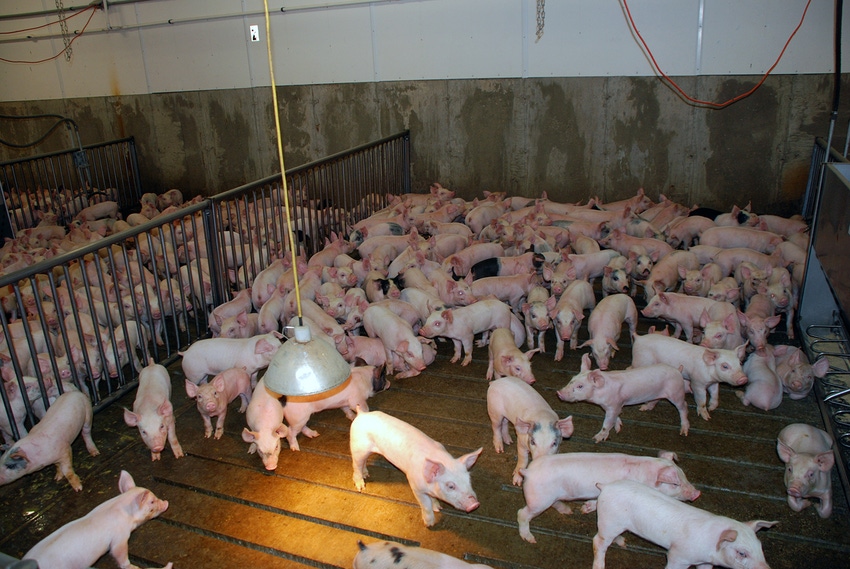
By Cyril Roy, Prairie Swine Centre, Saskatoon, Saskatchewan
Space allowances given to pigs can affect the economic viability of farms and also the health and welfare of animals. While there has been a significant body of research studying the effects of space allowances on grow-finish pigs, little information is available regarding the effects on nursery pigs.
Studies have shown that providing an optimal space allowance increases productivity by maximizing feed intake and the average daily gain of animals. However, optimum economic performance is influenced by high growth rates as well as by increasing the number of pigs per pen and overall barn throughput. The optimum for space allowance for maximum economic returns is lower than that for achieving maximum growth rate. As well as affecting ADG, providing space allowances below optimal recommendations can also negatively affect the welfare of the pig, with risk of immune suppression, increased disease susceptibility, restriction of normal behaviors and an increase in damaging behaviors.
As a result, establishing optimal space allowance requirements requires consideration of economic, health and welfare factors.
When recommending space allowances for farm animals, researchers use an “allometric” formula which uses the average body weight and a constant (k) to calculate the space allowance needed per animal. When this formula was used to estimate space allowances for grow-finish pigs, it was concluded that a k value of 0.0335 (equivalent to 0.7m2 of space for a 100 kilogram finisher pig) provided optimal space and maximum ADG. When pigs were given more space, no increase in ADG was found, but when space allowance was reduced below this value ADG dropped, in proportion to the crowding.
The same space allowance (k value) has been proposed for nursery pigs; however, young pigs behave very differently from older animals and may have different space requirements. For example, nursery pigs perform more overlying behavior, and thus may have a lower optimum space requirement than finisher pigs. With ongoing reductions in antibiotic use increasing concerns for animal welfare and getting the weaned pig off to a good start, finding appropriate space allowances based on animal behavior, health and performance considerations will be the way forward.
This column presents some initial results from research done at the Prairie Swine Centre on space allowances for nursery pigs. The studies were carried out on a research farm and on two commercial farms. Measures included productivity (ADG), feed efficiency, behavior and stress physiology, with the goal of identifying the critical cut-off at which crowding occurs and to address areas where uncertainty remains.
Methods
To compare effects on a research farm to those on a commercial site, the study was done in two phases; with controlled trials at the Prairie Swine Centre in Saskatoon (Phase 1); and commercial trials at two farm sites (one in Saskatchewan and one in Manitoba: Phase 2). In Phase 1, a total of 1,200 weaned pigs were studied in the nursery rooms at Prairie Swine Centre for approximately five weeks. Piglets were given six different space allowances (k= 0.023, 0.0265, 0.0300, 0.0335, 0.0370 and 0.0390); pigs were weighed weekly, and pen size adjusted to maintain the targeted space allowance.

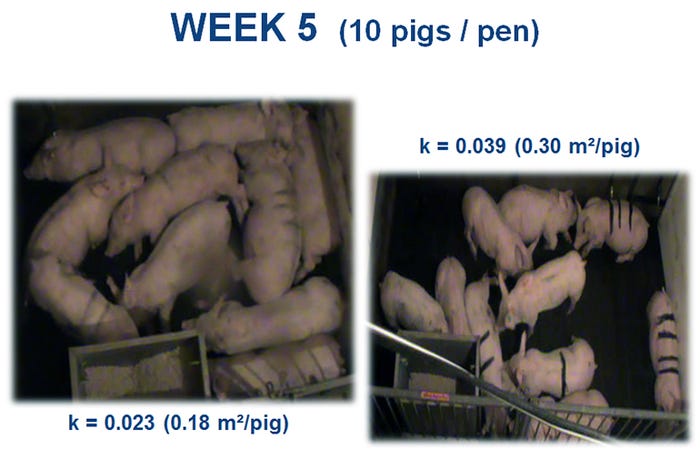
Group size is another important factor affecting social interaction among pigs. Some researchers have argued that larger groups require less space, due to the increased sharing of free space, while others have disputed this finding. In Phase 1, pigs were housed in groups of 10 and 40 to study interactions between group size and space allowance.
Commercial trials (Phase 2) were done on two farms using the same six space allowance treatments used in Phase 1 however, pens remained static in size. The number of pigs per pen was adjusted to target space allowance based on the nursery exit weight (25 kilograms) – ranging from 19 to 32.
Feed use was recorded and pigs were weighed at nursery entry, 3 and 5 weeks. Cameras were placed above each pen in weeks 1, 3 and 5, to record standing, sitting, lying, feeding and drinking behavior. Lesions on pigs were recorded to evaluate aggression, and saliva samples were collected on the research farm at three time points to measure pigs’ stress response.
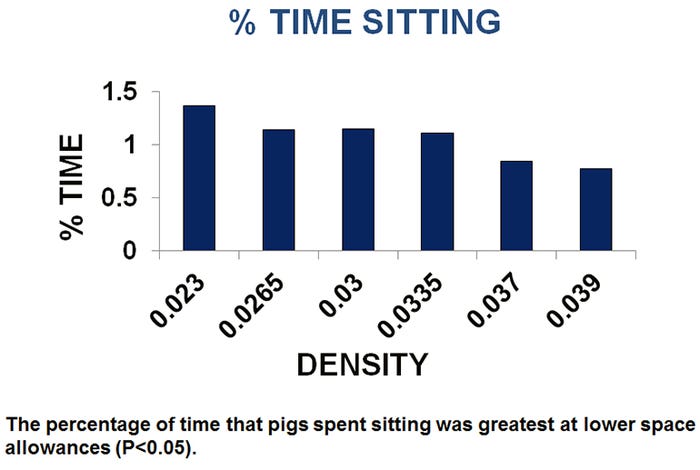
Results and discussion
On the research farm, space allowance had no effect on the average daily weight gain, feed intake or feed efficiency. However, at the commercial sites lower space allowances showed reduced average daily gain, particularly from midpoint (Day 21) to end of the trial (Day 45).

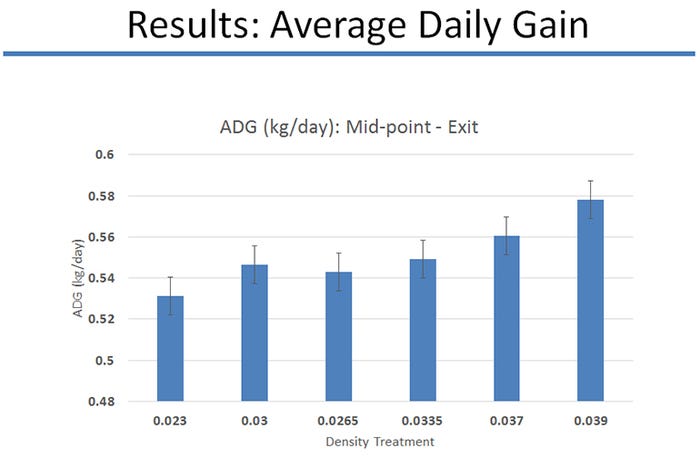
The lack of space allowance effects on growth on the research farm compared to the commercial sites was likely due to the high-health status and added care provided on the research farm. Space allowances were adjusted weekly on the research farm to increase the impact of space allowance, but despite this no impact on growth was seen. In contrast, the commercial sites had a constant space allowance, giving pigs relatively more space during their first weeks in the nursery with crowding increasing gradually over time, but space allowance had a significant impact. Antibiotic reduction studies have also found fewer effects in the research herd, due to the reduced challenge in a controlled, high-health environment.
Behavior measures can be helpful in interpreting these production results, as pigs will adjust their behavior to compensate for crowding before changes in growth are seen. For example, in finisher pigs housed in large groups, studies show that pigs will adjust their feeding behavior to eat fewer meals per day, with longer feeding bouts because it requires more effort to access the feeder. In this study, more nursery pigs were observed sitting at lower space allowances, and on the commercial farms there was a large increase in sitting in Week 5, compared to Weeks 1 and 3. Sitting has been suggested to be a “cut-off” strategy in pigs and an early indicator of stress. Pigs also did less lateral lying (lying on their side) at low space allowances, presumably due to crowding.
Feeding and drinking behavior were both affected by space allowance and group size. As space allowance was reduced, the total time spent feeding dropped from 49 to 44 minutes per day and the average length of feeding bouts decreased from two to 1.9 minutes. However, the number of feeding bouts per eight-hour day increased from 23 to 25. Similarly for drinking behavior, reducing the space allowance given to pigs resulted in less total time spent drinking, reduced the average drinking bout length and increased the number of bouts per day. However, when group size was increased, the total time spent drinking increased. One theory is that pigs in the larger group were more active and therefore drank more, however, this cannot be confirmed as water consumption was not recorded.
The behavior of nursery pigs changed greatly during their time in the nursery. Sternal lying and overlying reduced as pigs grew, and sitting increased. Overlying behavior showed the greatest change, and reduced by 50% after the first week. This observation refutes previous suggestions that nursery pigs require less space due to their propensity to overlie. However, this study shows that pigs’ willingness to overlie is drastically reduced after the first week in nursery, and is lowest at the end of the nursery period when space allowance is lowest.
Conclusions
In this preliminary analysis, lower space allowances (below k 0.0335) had a negative impact on average daily weight gain, especially between Weeks 3 and 5 on commercial farm sites. Space allowance also affected the feeding and drinking behavior and postures of pigs. Changes in behavior can be used as an early indicator of potential impacts on productivity. Overlying behavior reduced significantly soon after weaning, indicating that pigs are less willing to overlie at the end of the nursery phase, when pigs are most crowded, so this behavior cannot be used to justify reduced space allowances.
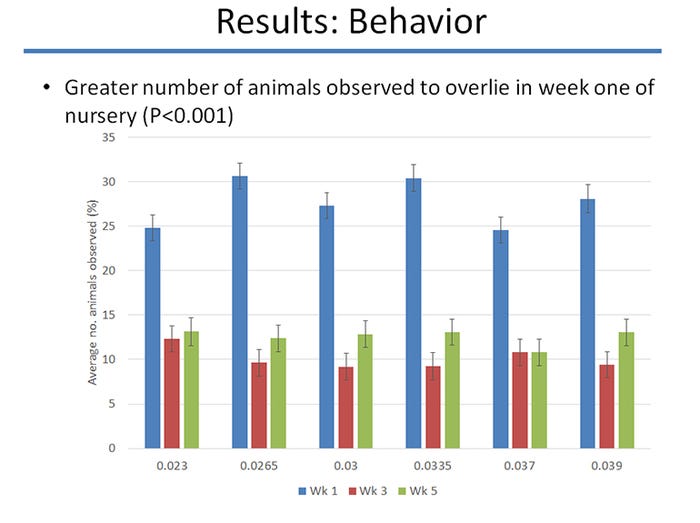
While further analysis is needed to draw firm conclusions from this study, the results indicate that pigs reared under commercial conditions were more susceptible to crowding stress than those managed under research farm conditions. Weaning and nursery are critical stages in pig production and are highly stressful. With increasing pressure to reduce antibiotic use, it will be even more important to consider space allowances in the nursery, and to ensure that pigs get a good start on life.
You May Also Like



